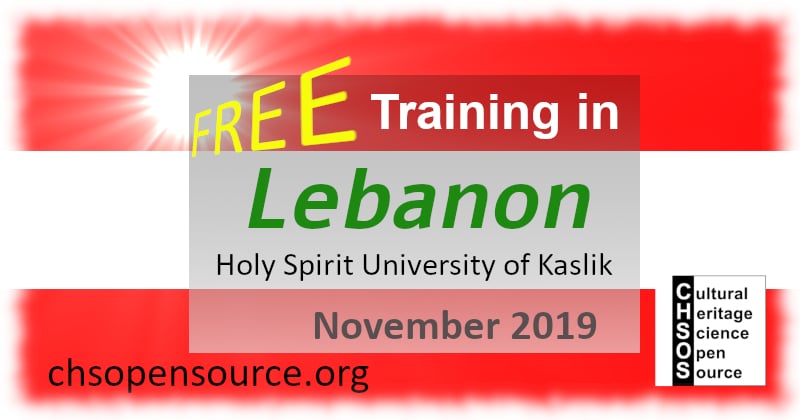
Four-day training course held at the Holy Spirit University of Kaslik and the Beit Gazo Center, Jounieh, Lebanon. Feb 3-6, 2020.
Organized by the IFLA PAC Centre at the Qatar National Library, in cooperation with the Holy Spirit University of Kaslik and the Beit Gazo Center in Jounieh, Lebanon. A four-day training course on Practical Methods for the Scientific Examination of Library Objects

The course was conducted by Dr. Antonino Cosentino, Director of Cultural Heritage Science Open Source and Maxim Nasra, Book Conservation Specialist at Qatar National Library.




Days 1 Holy Spirit University of Kaslik
Technical Photography
Technical photography represents a collection of images taken with a modified digital camera sensitive to the spectral range (about 360 – 1000 nm). Different lighting sources and filters are used to acquire a selection of technical images, with each one providing different information about the object under examination.

This training was a lot about iron gall ink. After the Middle Ages, this ink became the most used ink in manuscripts, because it is not easy to erase. It was also used for drawings because of its characteristic pleasant tone. Though, the ink turned out to have very corrosive properties and can destroy its entire paper support as shown in many cases. Before actually completely “eat” the paper, the ink starts to spread making in most cases the text unreadable. Infrared photography turned out to be a valuable method to read the actual writing. On the other hand, the faded ink could be read using UVF photography.

Day 2 – Holy Spirit University of Kaslik
Technical Photography, practical section


Day 3 – Holy Spirit University of Kaslik
Reflectance spectroscopy
Reflectance spectroscopy (RS) is a powerful portable technique for the identification of pigments in manuscripts and paintings. An RS spectrum shows the ratio between the intensity of the reflected light and the incident light for each wavelength. The RS spectra can provide information useful for pigment identification.


Day 4 – Beit Gazo Center
Practical training on technical photography and reflectance spectroscopy using heritage manuscripts found in the Beit Gazo Center.

This is the Centre de recherche et de Restauration du Patrimoine des Eglises d’Orient, in Daroun Harissa, Lebanon. The Catholic-Syriac patriarchate has made available premises free of charge for the new written heritage restoration centre – named Beit Gazo, or “House of Treasures” – inspired by the name of one of the most iconic of works in the Syriac language.

In Lebanon, Iraq, Syria, Palestine, and Egypt, Eastern Christian community libraries house very diverse collections of great value in the Syriac, Arabic, Coptic and Armenian languages. This heritage is an exceptional testimony of the presence of Christians in the Middle East during the first centuries of Christianity. As this heritage may be jeopardized by the passage of time and the violent conflicts shaking the Middle East, l’Œuvre d’Orient intends to protect and raise public awareness of it.

Do you need these methods also in your Institution?
CHSOS serves an international audience of institutions and art professionals such as conservators, art historians, art appraisers, fine art photographers, and conservation scientists. Its technical innovations and strategies are being adopted by museums and cultural institutions worldwide. CHSOS disseminates this knowledge through the CHSOS website, publications, and training programs.
- Our Training programs teach practical methods for Art Examination and Documentation. Our modules illustrate imaging and spectroscopy methods regularly used by cultural heritage scientists and conservators for the scientific and forensic investigation of art objects.
- All the training modules have hands-on activities and students practice with our CHSOS equipment. No need for you to bring any equipment.
- No specific educational background is necessary. Our courses are designed for a large audience ranging from art professionals to scientists.
We deliver Equipment and Training at your Institution. See what other professionals did with our service: Training for Institutions
Technical Photography (TP) kit
We offer a complete kit for Technical photography (TP) which includes a full spectrum camera sensitive from the Ultraviolet to the Infrared radiation and the set of necessary filters and lamps. Our TP kit represents a good compromise among quality, adaptability, and costs. It allows to realize a complete set of 8 technical photo documentation methods: VIS (visible photography), UVF (Ultraviolet Fluorescence photography), UVR (Reflected Ultraviolet photography), IR (Infrared photography), IRF (Infrared Fluorescence photography), IRFC (Infrared False Color photography), IRT (Infrared Transmitted photography) and RAK (Raking light photography).
This kit is recommended for art professionals such as conservators, art appraisers, archaeologists, art historians. Use it for a fast and informative examination of easel paintings, wall paintings, manuscripts, and historical documents.
Multispectral Imaging (MSI) system
Conservators and art historians need non-invasive methodologies to identify and map pigments on works of art and archaeology. These tools allow them to select appropriate conservation procedures, acquire information on the workshop practices, distinguish original sections from inpaints and to enhance visualization of faded pigments and inks.
Antonello is our simple MSI system composed of 18 bandpass filters and a digital camera, covering the 400-925 nm spectral range. Using a digital camera rather than a monochromatic scientific dedicated camera has the advantage that the same camera can be used for other technical photographic methods, making the overall imaging equipment lighter, compact and affordable.
We developed Antonello to spread the use of this methodology across Art Conservation professionals and institutions. Antonello, our low-cost MSI system for Art and Archaeology uses specifically designed in-scene gray reference targets and it is versatile and adaptable to the specific needs of different art or archaeology examination projects, such as manuscripts, wall paintings, and easel paintings.
We developed Antonello to be: user-friendly, compact and lightweight, easy to understand, tune-up and upgrade.






